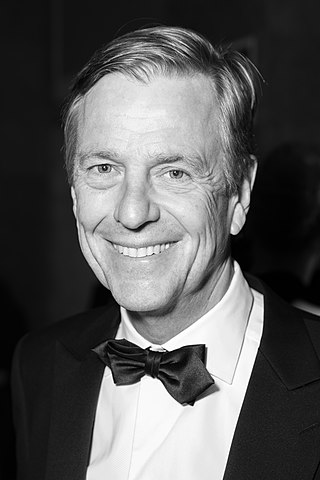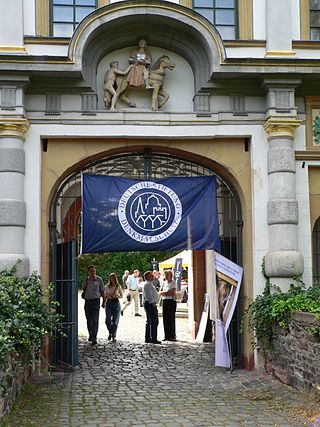Related Research Articles

Reiner Kunze is a German writer and GDR dissident. He studied media and journalism at the University of Leipzig. In 1968, he left the GDR state party SED following the communist Warsaw Pact countries invasion of Czechoslovakia in response to the Prague Spring. He had to publish his work under various pseudonyms. In 1976, his most famous book The Lovely Years, which contained critical insights into the life, and the policies behind the Iron Curtain, was published in West Germany to great acclaim. In 1977, the GDR regime expatriated him, and he moved to West Germany (FRG). He now lives near Passau in Bavaria.

Claus-Detlev Walter Kleber is a German journalist and former lawyer. He anchored heute-journal, an evening news program on ZDF, one of Germany's two major public TV stations. He is also known for his expertise in United States politics and German-American relations, as evidenced by his 2005 bestseller Amerikas Kreuzzüge.
Wolfram Hoepfner is a German classicist, archaeologist, architectural historian, and Professor of Ancient Architectural History, at the Free University of Berlin.

The New Frankfurt Old Town is the centre of the old town of Frankfurt am Main, Germany, which was reconstructed from 2012 to 2018 as part of a major urban development project called the Dom-Römer Project. The project redesigned and developed a 7,000 m2 (75,000 sq ft) property between Römerberg in the west and Domplatz in the east, delimited by Braubachstrasse in the north and the Schirn Kunsthalle in the south, in an effort to remake the old city centre, the Altstadt, which was severely damaged during World War II, in the style of the pre-war architecture.
Simone Augustin also Simone Roßkamp is a German journalist and author.

Herbert Köfer was a German actor, voice artist, and television presenter. He was the first German TV news presenter for the East German Deutscher Fernsehfunk, and also presented the station's last news before the reunification of Germany. His first theatre engagement was in 1940, and he kept acting until the age of 100. Köfer played an SS-Hauptsturmführer in the 1963 film Nackt unter Wölfen. He was known for detective series such as Polizeiruf 110 and for comic roles. He founded his own troupe, Köfers Komödiantenbühne, in 2003, and published memoirs.

Marc Kocher is a Swiss architect, known for his residential building designs.
Stefan Moses was a German photographer living in Munich.
Georg Ulrich Großmann is a German art historian. He was general director of the Germanisches Nationalmuseum in Nuremberg.
Bruno Flierl was a German architect, architecture critic, and writer. His work focused on architecture, urban development, and city planning of East Germany. He assisted in the design of the Pariser Platz and argued for the preservation of the Palace of the Republic in the debate over the restoration of the Berlin Palace.

Elmar Albrecht was a German painter and scenic designer.

The Tag des offenen Denkmals is an annual event all over Germany. The day of action has been coordinated by the Deutsche Stiftung Denkmalschutz since 1993. Historic monuments are open to the public free of charge. It takes place on the second Sunday in September and attracts several million visitors each year. The largest cultural event in Germany is the contribution of the country to the European Heritage Days.
Roland Weber was a German landscape architect.

Helmut Hentrich was a German architect who became particularly known for his striking high-rise buildings in the 1960s and 1970s. The architectural firm he founded, Hentrich, Petschnigg und Partner (HPP), still exists under the name HPP Architekten.

Volker Staab is a German architect.
Max Creutz was a German art historian and curator of the Museum für Angewandte Kunst Köln and the Kaiser-Wilhelm-Museum in Krefeld where he worked from 1922 until his death. In Cologne, in 1914 he was instrumental in the first exhibition of the Deutscher Werkbund, Deutsche Werkbundausstellung. In Krefeld, he succeeded in acquiring modern art exhibits, including works by Max Ernst, Wassily Kandinsky, and Alexej von Jawlensky. He included a substantial collection of art, crafts and design from the Bauhaus.
Rudolf Hillebrecht was a German architect and city planner. In 1948, against an impressive list of rival candidates, he succeeded in obtaining appointment as city planning officer for his home city of Hannover, with a mandate to rebuild a city that had suffered massive bomb damage between 1942 and 1945. He approached his task with evangelical zeal. His ideas for post-war Hanover aligned with the prevailing spirit of the "Wirtschaftswunder" years, and by 1959 it was possible to boast that Hannover was the only city in West Germany with its own network of city motorways, while Hillebrecht had probably become the only man alive in Hannover with an international reputation. Urban developments during the next twenty years repeatedly demonstrated the extent of Hillebrand's influence across and beyond western Europe. His redevelopment of Hannover was nevertheless not uncontroversial even at the time. A large number of historical buildings that had somehow survived Anglo-American bombing were now destroyed out of deference to a larger plan: some of the Hilebrecht plans involving wholesale destruction and replacement of entire districts of the city were indeed never implemented. Hillebrecht himself later conceded that the destruction, during the early 1960s, of Hannover's striking neo-Renaissance "Flusswasserkunst" had been a mistake.
Alfred Breslauer was a German architect of Jewish origin.

Elisabeth Niggemeyer is a Berlin based German photographer. Niggemeyer is best known as the photographer for Die gemordete Stadt, a classic critique of post-war German urban planning, and for her work on children and pedagogy created in collaboration with Nancy Hoenisch.

Die gemordete Stadt is a classic critique of post-war German urban planning by journalists Wolf Jobst Siedler and Gina Angress and photographer Elisabeth Niggemeyer. It was originally published in 1964, and re-published in 1979 and 1993. It has been called the most influential book on architecture in post-war Germany, and its effect has been linked to that of Jane Jacobs' The Death and Life of Great American Cities in the United States and Canada.
References
- 1 2 3 4 5 6 "Greeting by Dr Dankwart Guratzsch at the 2007 Association Day of Saxon House & Land Owners". Stadtforum-Chemnitz.de. 9 May 2007. Retrieved 5 June 2021.
- ↑ "Staff member of the week: Dankwart Guratzsch". Welt.de. 15 August 2015. Retrieved 5 June 2021.
- ↑ "Staff member of the week: Dankwart Guratzsch". Welt. de. 15 August 2015. Retrieved 5 June 2021.
- 1 2 Rainer Haubrich (14 June 2004). de/print-welt/article320201/Die-Geschichte-die-Stadt-das-Haus-Dankwart-Guratzsch-wird-65.html "The History, the City, the House: Dankwart Guratzsch turns 65". Welt.de. Retrieved 5 June 2021.
{{cite web}}: Check|url=value (help) - 1 2 Dankwart Guratzsch (6 July 2002). "Kulturelle Zeitenwende". Welt.de. Retrieved 5 June 2021.
- ↑ Dankwart Guratzsch (27 December 2018). "Does Dresden Need a Bombing War Museum?". DNN.de. Retrieved 5 June 2021.
- ↑ "Committees of the Deutsche Stiftung Denkmalschutz". Denkmalschutz.de. Retrieved 5 June 2021.
- ↑ Dankwart Guratzsch (15 November 2013). "Nothing but botches". Welt.de. Retrieved 5 June 2021.